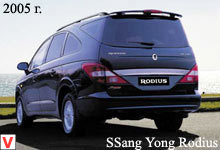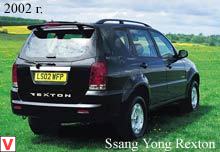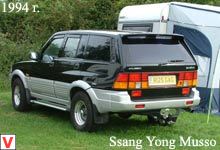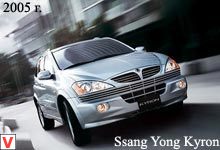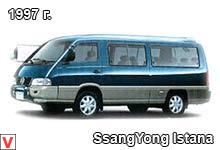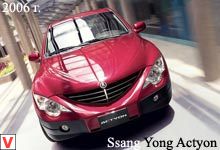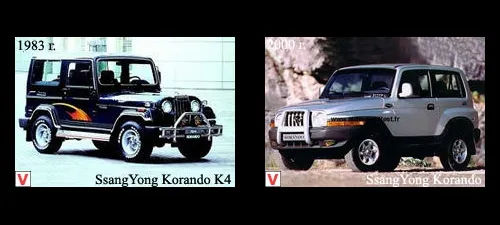
Long before the Korean automaker Ssang Yong entered the civilian market, they were licensed American CJ 7 jeeps, which served as the basis for the prototype Korando. In the 1980s, the Korando K4 appeared. He very much resembled his ancestor - the American Jeep - and was produced in small quantities for the needs of the South Korean army. Equipped with dependent suspensions with leaf springs and 2.2 liter atmospheric diesel. In 1988, Ssang Yong began producing a car under the name Korando Family. This was already a large 5-door SUV, built on the basis of the Isuzu Trooper (Korando Family was equipped with 2.2 liter and 2.5 liter diesel engines with a power of 68 hp and 79 hp).
In 1995, at the London Motor Show, he made his debut concept under the symbol KJ, which after the start of production in 1997 was named Korando. Korando is an abbreviation of the English phrase “Korean can do!”, Which means “Koreans can do!” In Russian. The extravagant design of the car was developed by the British stylist Ken Greenlee, who by then had experience with brands such as Aston Martin and Bentley. The tapering hood, edged bulging wings, a large grille and built-in trips remind you of the relationship with the legendary military jeeps. Round headlights, on the one hand, - the last century, and on the other - a classic.
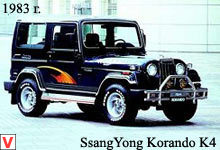
The SUV is produced with only one base length - 2840 mm and two body types: the three-door Hard Top all-metal wagon and the Soft Top convertible with two doors (appeared in the autumn of 1997). The salon is quite comfortable and spacious enough for four people (five can accommodate). Interior plastic, imitation wood, looks modern. The rear seat with removable armrests can be folded in parts and thus increase the trunk from 350 to 1200 liters.
The instrument panel is symmetrical, i.e. the contours of the dashboard exactly match the outline of the panel in front of the passenger, only in front of him instead of the devices there is a large niche for things and under it a roomy glove compartment. Devices under the classics, round, with no frills and well visible.
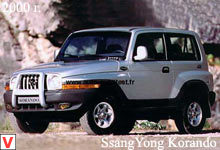
The standard Korando includes power steering height-adjustable steering wheel, electric mirrors and power windows, air conditioning, driver's airbag, central locking and metal protection of the engine crankcase. The front suspension is independent torsion bar on double wishbone, rear - usual dependent with springs. It behaves with dignity as with high-speed driving on the highway, and on uneven. A four-wheel drive transmission with a dual-stage transmission and a self-locking rear differential allow you to climb much farther off the road than any off-road SUV can afford: the "army roots." Brakes are equipped with ABS from Bosh.
Under the hood of the Korando can be found three petrol engines: 4-cylinder 2.0 liter. (126 hp), 2.3 l. (150 hp, 160 hp, but more often 140 hp) and the most powerful in-line 6-cylinder volume of 3.2 l., Which produced 209 hp, and then all 220 l. from. (cars with petrol power units were designated as “series“ E ”). SUVs with diesel engines were called the “600 series”. Now you can find on sale three different engines on diesel: a volume of 2.3 liters. (4-cylinder, 77 hp, 80 hp or 101 hp, depending on the version and year of production), 2.9 l.
(5-cylinder, without turbocharging, 98 hp) and 2.9 liters. with the turbine (already 129 hp). All models are equipped with either a five-speed manual gearbox or a four-band "automatic" manufactured by Borg Warner, whose products are successfully installed on many Mercedes-Benz cars. In the late 90s, SsangYong’s automotive division was sold to Daewoo. So Daewoo Korando appeared. However, Daewoo itself soon found itself in a financial crisis, and in the 21st century, SsangYong resumed production of cars under its own brand. In 2003, the Korando model has undergone a slight restyling. And in 2006 she was replaced by Actyon.
In 2008, SsangYong Korando began to be produced at the Taganrog plant under the name TagAZ Tager. The car did not change anything and it is a complete copy of the South Korean Korando. In 2008, the SsangYong C200 Concept was introduced at the Paris International Auto Show. The serial version was planned to be presented in the autumn of 2009 at the Frankfurt auto show, however, due to financial difficulties, the timing of launching the crossover into mass production was revised. The serial version of the SsangYong C200 was unveiled at just May 2010 at the Busan International Auto Show. In the domestic South Korean market, the car received the name Korando C.
So the second generation Korando appeared. In Russia, the car is better known under the name Actyon. The company has completely changed the design and technical equipment of the SUV. This is the first car in the SsangYong model range with a monocoque body. Stylish and holistic exterior, well-thought-out interior space, the newest eco-friendly turbo diesel engine, excellent handling characteristics and a wealth of equipment allowed the Korando to become a worthy competitor in the crossover class. The main advantage of the 2011 model year Korando compared to its predecessors is the modern, attractive design. To create the car attracted Italian design studio Giugiaro.
The front part got a more pleasant appearance: streamlined wide headlights, front bumper looks like a single unit with the hood and grille, miniature fog lights are built in from below. Salon SUV quite spacious. The central panel is made with care to the car owner. A large number of function buttons were adapted to one, or rendered on the navigation menu.
Comfortable seats have tangible lateral support. A large amount of space is allocated for different things, it is the armrest, enlarged glove compartment, under which there is also a niche for different things. Special attention also deserves the excellent insulation of an SUV.
Under the hood, a 2-liter diesel engine with a capacity of 175 hp With him, acceleration to 100 km / h takes 10.8 seconds. There are modifications with 6-step mechanics and with a 6-speed automatic.
